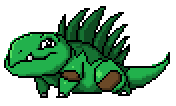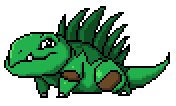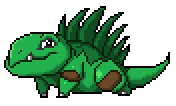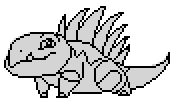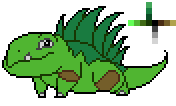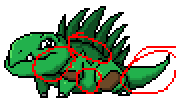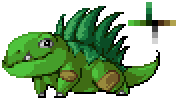http://grooveshark.com/#!/s/Tides+Of+Time/3ztD8k?src=5
This took WAY too much work to get onto here. Anyway, Fox Amoore is a professional musician who does a lot of piano work, and happens to do some video game covers on the side. This one, of Ecco II: The Tides of Time, is very evocative of the feel I get from the dying world described in Polaris's fiction. It was also the theme song for me during the final chapters of Kurt Vonnegut's Cat's Cradle.
Why is there such a consistent trend of amateur musicians out there being furries? It baffles me. Doesn't change the fact that he's a great artist though.
So today I played Polaris with Adam, Kelley, and Arnold (last names redacted for privacy) over Google+ Hangouts. I've owned the Polaris rules since Christmas, but didn't think I'd have a chance to use them for a while! I mean, Kenny/Kris/Dan/Luke aren't exactly up for this sort of game, or that's what I had in mind. It takes a bit more of a serious tone, and I'm pretty sure we couldn't do it justice - not with only one person (me) willing to give a full read of the book and having never played myself. I've talked to/seen Arnold around the Story Games forum every so often, though I don't know Adam. Kelley I didn't know either - except through amazing coincidence, she was the MC for the over-the-web Monsterhearts game that Paul T playtested my Doppleganger in! So I'd watched a session of their game about a week before actually gaming with her, which is pretty funny.
So, after bumbling through some tech-issues, we played Polaris! Polaris is a game by Ben Lehman about "Chivalric Tragedy at the Utmost North." That's the subtitle for the game on the back. Here's the blurb, the closest I can get to an elevator pitch here.
Once upon a time, as far north as north can go, there lived the greatest people that this world will ever know. We cannot look upon them as they were, but we can understand them as they die, melting like a snowflake in the sun.
This is no longer a history; this is not yet a story. This is all that remains. Whatever else is what you make of it.
Now,
I've read the fluffy canonical-background chapter, and Arnold knew it, but Kelley and Adam hadn't. And so, we ignored it, because it's like 30 pages of somewhat arcane flowery descriptive text. We took the most important bits: we're all Knights of a Queen of this city that is constantly under attack by Demons. That's it. We didn't mention King Polaris or the Dawn or any of that stuff because we don't care.
I do recommend to anyone who gets the text that they should totally read it if they have some spare time to devote to some awfully poetic text, cuz it's a neat story and setting, but the game didn't need it to function.
Okay, I should explain the system real quickly. There are four players, and each player takes a stance on each character: the Heart, the New Moon, the Full Moon, and the Mistaken. Scenes move around the table in a Fiasco-esque manner, a scene per character per round. The Heart is the character's player. When it is your character's turn, you, the Heart, advocate for your character. When it is your turn, the player to your left is the New Moon, and controls secondary characters with personal and interpersonal relationships with you. On your right is the Full Moon, who controls secondary characters with social and hierarchical ties to you. Across from you is the Mistaken, who plays the antagonists of your character - they are the ones you will have conflict with.
When it is the Heart's turn, you frame and narrate a scene, going through free play until the Mistaken takes issue with something you say, at which point they start a conflict. Conflict is resolved using Key Phrases, sets of words that you use to negotiate a different outcome to the scene. Your conflict phrases are:
*
But Only If: A sort of "Yes, But," adding a condition to the action. They can reply with any ritual phrase.
*
And Furthermore: If But Only If is "Yes, But," this is "Yes, And," tacking on even more that happens. They can't respond with But Only If or It Was Not Meant To Be.
And Furthermore must be justified with a use of one of your themes. I'll get there.
*
It Shall Not Come To Pass: This is where you put it up to the dice to decide whether you get what you want. On a success, you get what you want, conflict's over. On a failure, the Mistaken gets what they want, conflict's over.
*
You Ask Far Too Much: The Mistaken isn't being reasonable, and you want them to provide something else. They give you either a lesser version of the same, or something radically different, and you have to pick between the old (unreasonable) statement and the new option.
You also need to use one of your themes on this one.
*
It Was Not Meant To Be: A conflict-ender, this is where you give up on your attempted action to try and minimize the consequences.
*
And That Was How It Happened: A conflict-ender, this is where you accept the conditions and play continues with all statements true.
The themes I was talking about are a lot like Aspects in Fate or Traits in Dogs In The Vineyard. They're sorted into Offices (formal positions, authorities), Blessings (artifacts, actual stuff), Abilities (stuff you know, stuff you can do), and Fates (events, common ties for players, relationships). We also put names inside each of the New Moon/Full Moon/Mistaken categories.
We also have scores for the stats Zeal, Ice, Light, and Weariness. Zeal starts at 4, Ice and Light are at 1, and Weariness is 0. As we advance (level up) our Zeal falls and our Ice and Light rise. When we're out of Zeal, Weariness starts rising instead. Ice is for fighting internal and social demons, Light is for actually killing monstrous demons.
Oh, and did I mention that the game is GMless?
All characters start with a certain set of aspects, one for each theme. Everyone has the Office
Knight of the Order of the Stars, has the Blessing
Starlight Sword, and the Ability
Lore of Demons. Everyone also has a similar Fate to tie us together - all of us but Arnold put
Doppleganger Among Us, while Arnold had
Demons Among Us. This may have been miscommunication or intentional, I dunno, it's not actually very important. In addition to that, everyone had two Aspects of their choice. Let's just go through the characters now!
POLARIS
Starring...
Arnold as Musca! I (Max) am his Full Moon, Adam is his New Moon, and Kelley is his Mistaken!
Kelley as Rasalus! Adam is her Full Moon, I am her New Moon, and Arnold is her Mistaken!
Adam as Ascella! Arnold is his Full Moon, Kelley is his New Moon, and I am his Mistaken!
and me, Max/Ego as Algol! Kelley is my Full Moon, Arnold is my New Moon, and Adam is my Mistaken!
Musca has the Office aspect
Curator of the Leftmost Museum, and the Blessing aspect
Horns of Suhail. He is a seasoned knight, and very well informed. The horns are an ancient and treasured artifact of the knights, long-ago taken from the great demon Suhail - and it desperately wants them back. In matters of academics, he is often called upon.
Rasalus has the Office aspect
Chaperon to Prince Azhure and the Blessing aspect
Formless Key. Many moons ago he left training at the top of his class and was placed as the Prince's guard, and he's awful rusty from it. He's not happy with his position, and secretly wishes the Queen ill so he can be free of the prince (as there'll be no need for him once Azhure is king). His formless key has yet to meet a lock it cannot open.
Ascella has the Office aspect
Youngest Initiate and the Ability aspect
Lore of Colors. Somewhat able at magic, he was, well, not the top of his class, out-done often by Kuma. He is apprenticed at the museum under Musca, and once tried to put out Algol's star as an experiment. He is in love with Prince Azhure. His Lore of Colors is the style of magic he employs and is learning from the Museum.
Algol has the Blessing aspect
Heart of a Dying Star and the Ability aspect
Technique: Rise From The Grave. Algol is a violent and hardened knight who fights until his death on the battlefield, only to awaken later. Prophecy says that when his dying star goes out, he will finally die his last death, but that doesn't keep Algol from wielding it on the front lines as one of the greatest weapons in the knighthood's arsenal. He trains the recruits as well, including recently Kuma and Ascella. He is Rasalus's brother. It is no secret that Algol is dead - he take pride in his ability to continue to give to the kingdom.
We also have a cast of supporting characters!
Prince Azhure is the son of the great Queen, and is under the supervision of Rasalus. He is the object of Ascella's love.
Kuma is a new Knight also apprenticed at the Museum. Highly skilled in many arts, she is the darling of rising star of the latest crop, much to Ascella's resentment. Algol is impressed with her abilities and has placed her on his squad when they go out into battle. She is a proxy daughter for Musca.
Sarin is Kuma's mother, and has a close relationship with Musca.
The Order of the Prism is the mystical organization for magic-users that Ascella is desperate to join.
Gameya is Rasalus's girlfriend.
Tarf the Seer is the court's grand diviner, and the brother of Ascella. Tarf has accused Algol of being the doppleganger introducing treachery into the ranks of the knighthood.
Suhail the Demon Chylde is desperate to get his horns back from Musca, but knows not how to find them.
Giauzar the Dragon is a demon of incredible power. Musca wishes to slay him with his bare fists. He has slain Algol several times in combat, and Algol wants revenge.
Ymri is an Ice Demon who is Rasalus's greatest foe.
We started off with Adam and Ascella (meaning I'm the one who gets to object at things he does), framing a scene where there's an exhibition going on at the Museum showcasing a dissected demon, with Kuma giving the narration and explanation of the various parts and such, with everyone in attendance - Rasalus is here with the Prince, Musca is nearby, Algol is there resenting that he has to sit through the presentation ("I've woken up
inside demons, I know my way around their parts. I don't need to be lectured.") Ascella is skulking about the area, kinda miffed that he's been entirely looked over in favor of Kuma again, but it's not so bad because the Prince is here. Adam asserts that Ascella sneaks by under Rasalus's nose and slips a note into Prince Azhure's pocket without anyone noticing. The note says to meet him in the Cloud Observatory at the top of the Museum, signed as, like, a secret admirer.
We flitted forward in time, Ascella and Azhure are up in the Observatory, discussing stuff like Azhure just wanting some more freedom and stuff. Now, remember that this is all just free narration on Adam's part so far - that's kinda stressful, and I probably should've jumped on a conflict a little faster (the undetected secret note was probably him cue-ing a conflict) but at this point I knew where I was gonna hit him. Azhure mentioned that he didn't actually ditch Rasalus - he'd just asked for a bit of privacy. After a few more moments of charged silence, Ascella went in for the kiss - and THAT was where I hit with a conflict phrase. Not that Azhure would pull back or anything, but I said he could have the kiss "But Only If" Rasalus walked in in the middle of it. He, uh, took it without complaint. That's when Rasalus burst into a bit of rage, yelling and pummeling the young knight for being the first one to slip through his fingers - this anger was part fear-of-failing, part anger-at-threat-to-the-prince, and part this-has-never-happened-before-am-I-getting-old-or-what. THAT Adam didn't want to take, so he said "You Ask Far Too Much" and spent his Office theme - he's the youngest initiate, surely Rasalus would not be that physically brutal. I offered up my alternate, that instead of being beaten senseless, Rasalus would immediately drag him before the Queen. Adam bounced back "But Only If" he still won over the prince's heart, and I let him have that and ended the conflict.
So It Was.
Adam didn't get any Experience this round - he failed no rolls and wasn't particularly cynical or dark. I mean, he gave up his safety for true love, he's freakin' hopeful.
We moved to the next scene, this time it would feature Rasalus. Kelley made it an immediate follow-up scene, dragging Ascella before the Queen. I confess - I don't actually remember too much of this scene. I DO know that the end result was that Ascella would be allowed to live, but Rasalus had to take personal responsibility for his life. This is added responsibility on Rasalus, AND it implies that Ascella is gonna have some REAL grunt-work to do, rather than his cushy Museum apprenticeship. Rasalus also negotiated for some greater freedom to operate and to have his girlfriend closer. Also, the final complication that was added in wasthat, as he turned away, Rasalus saw the twinkling of Ymir in the Queen's eye. What exactly that means has yet to be see, but it cannot bode well...
So It Was.
Sorry Kelley that I don't have too much memory of this scene. I think I was running my own brain as fast as I could trying to figure out what the hell I was gonna do with my own scene.
Kelley also got experience from the scene, and got an advance. Rasalus's Zeal dropped to 3 and she raised his Ice to 2.
The third scene was mine, featuring Algol. Adam was my opposition. I framed Algol going to the palace after the Museum exhibition, doing his general patrol route that he occasionally gets assigned (he hates it), checking in on various recruits, etc. until he's down in the basement/dungeon area, moving along on his patrol when he hears low chanting from down the passage. He moved along, quietly approaching, the voice getting louder as he got closer, until he was hiding just out of sight next to the door it was coming through. Looking through the crystalline door, he could see the figure of Tarf the Seer speaking to a shadowy for- no, not a shadowy form, an actual being made of Shadow, a demon. Gripping his weapon tightly in his left hand and forming his starlight sword in his right, he stepped out, kicked his way straight through the crystal door and rushed forward. Stretching out his hand, the dying star flared its brilliant red as it lashed out, obliterating the demon.
Wait. But Only If!
Adam said that I could have that if, as I destroy this creature of shadow with my fading light, the star draws in the shadows and causes it to go into implosion, bursting out into a black hole. He Asks Far Too Much! I spend my Lore of Demons, I know my demons and there's no way I would have attacked like this if it could have been so catastrophic to my Star. Adam provides the alternative that the demon instead seeps into Algol, and yeah, I can deal with that.
Scene's not over yet though, Tarf's still here! Having blasted the demon to oblivion, Algol swings around, slamming Tarf in the head with the flat of his Starlight Sword, and pinning him to the ground. Adam comes around "But Only If" this Tarf is actually just a simulacrum! And yeah, I can deal with that, so as my sword slams into his head it passes right through and the whole body crumples into a pile of snow, and Algol gets out of there
So It Was.
Algol totally got Experience - I took a demon into me. And was a vicious mother-fucker - I kinda feel like Algol is totally the lead front-liner of the knighthood since he never stops going, plus he has an incredible weapon. But I blew the Experience roll - instead of an advance, I got a refresh, recharging my themes so I have some more freedom with my phrases.
The final scene of the night went to Arnold and Musca. Musca was sent along to the palace dungeon to investigate the pile of snow in the room with the shadow bits on the floor (and probably scorch marks on the walls and ceiling - Algol doesn't know subtlety with that thing :/). He's brought Kuma along for educational purposes. While he's in there, he's doing his magic-forensics thing and decides to steal away a bit of the snow for further analysis - he tucks it into one of the hollowed out Horns of Suhail. Kelley only lets him do that if putting that magic-laden snow in it alerts Suhail to their location. Arnold reverses that yeah, that's cool, but only if he brings along a horde for the assault. Kelley agrees, but says that Suhail gets to kill Kuma pretty much immediately. Arnold pushes it with a dice roll, but fails. Arnold eats the loss and Suhail rages forward, appearing in the space. Seeing all the knights around, he turns to retreat to get backup, but as he goes, he slams one of his arms into Kuma, whose neck breaks as she hits the ground.
In a panic, Musca races to the somewhat-nearby Algol, who uses his Dying Star to try to bring Kuma back to life. It works - partially. Musca must feed her the blood of a demon weekly for her to keep her recaptured soul. Musca agrees, and finishes by uttering a challenge, in a voice that demons realm-wide can hear, to Suhail, challenging him to single combat. Arnold tried to negotiate to get Giauzar there too, but couldn't get it out of Kelley.
So It Was.
Arnold pulled some experience from a failed roll he'd made. He got an advance, and upped his Light to 2 as his Zeal dropped to 3.
That was the game! It was a lot of fun. I was really iffy about ritual phrases to start with, but they were starting to get natural by the end. With a touch more practice, this could really hum along.
A regular theme of the game was, unfortunately, that looking through the book was a nightmare. No indexing, not clearly or easily organized, and the text is full of flowers and fluff, which, while it makes it evocative and interesting to read, makes it pretty bad as a reference text. When the game was going though, things really did work.
Hey, so I mentioned Art, right? Well, I illustrated my favorite image from the night.
Click for full-size.
So, uh, did I mention that according to the book, Algol means
A Ghoul, or
A Demon Star? That name is pretty much where everything else came from. He's a fucking beast. And like all good dying stars, it's blood red. Image-wise, it was quite an exercise trying this pose anatomically. Also, deciding how to clothe him was actually kind of a really hard time - I hate doing fashion for my guys, it's hard to make it interesting yet also easy enough for me to make it follow the form and not kill myself actually doing it. I'm pretty happy with how the clothes came, and very happy with the piece as a whole. You might notice that the crest there technically breaks from the fabric contours - a) I'm not doing that shit or I'd never be happy with it, and b) it looks better this way. Gives the image a sort of emblem. That crest is unique to Algol btw.
You know, doing this image and thinking about Algol, I realized, he's not a Polaris character. He's a fucking Mythender.
As a side note, this piece could make for a great Firebender picture with not-that-much changing. Might do that eventually if I need to recycle some assets.
Anyway, the game and the art-ing were both a ton of fun. We're talking about trying to play again sometime, though it may not materialize for a while. Well, now that I've actually written an AP post the day I played, I'm going to bed, it's fuckin' 4am.
End Recording,
Ego.

